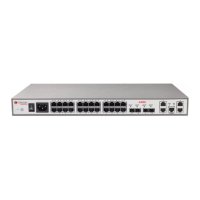A10E/A28E/A28F Configuration Guide
Figures
Figure 1-1 Accessing the A10E/A28E through PC connected with Console interface 2
Figure 1-2 Communication parameters configuration in Hyper Terminal 3
Figure 1-3 Networking with the A10E/A28E as Telnet server 3
Figure 1-4 A10E/A28E as Telnet client networking 4
Figure 1-5 Configuring auto-loading 32
Figure 2-1 MAC application networking 39
Figure 2-2 Dividing VLANs 41
Figure 2-3 Typical networking with basic QinQ 46
Figure 2-4 Basic QinQ networking application 49
Figure 2-5 Selective QinQ networking application 52
Figure 2-6 Networking with VLAN mapping based on single Tag 54
Figure 2-7 VLAN mapping application networking 57
Figure 2-8 Interface protection application networking 60
Figure 2-9 Port mirroring principle 63
Figure 2-10 Port mirroring application networking 65
Figure 2-11 Layer 2 protocol transparent transmission application networking 69
Figure 3-1 Configuring ARP networking application 75
Figure 3-2 Layer 3 interface configuration networking 78
Figure 3-3 DHCP typical application networking 81
Figure 3-4 Structure of DHCP packets 81
Figure 3-5 DHCP client networking 83
Figure 3-6 DHCP client networking 85
Figure 3-7 DHCP Relay application networking 86
Figure 3-8 DHCP Snooping networking 89
Figure 3-9 DHCP Snooping networking application 92
Figure 4-1 Traffic classification 98
Figure 4-2 Structure of IP packet head 98
Figure 4-3 Structure of IP priority and DSCP priority 98
Figure 4-4 Structure of VLAN packets 98
Figure 4-5 Structure of CoS priority packets 99
Figure 4-6 SP scheduling 101
Figure 4-7 WRR scheduling 101
Figure 4-8 Configure queue schedule networking 115
Figure 4-9 Rate limiting based on interface 117
Figure 5-1 Mapping relation between IPv4 multicast address and multicast MAC address 121
Figure 5-2 IGMP Snooping application networking 136
Figure 5-3 MVR application networking 138
Figure 5-4 Applying IGMP filtering on the interface 141
Figure 5-5 Applying IGMP filtering in the VLAN 143
Figure 6-1 Configuring secure MAC address 158
Figure 6-2 Principle of dynamic ARP inspection 160
Figure 6-3 Configuring dynamic ARP inspection 164

